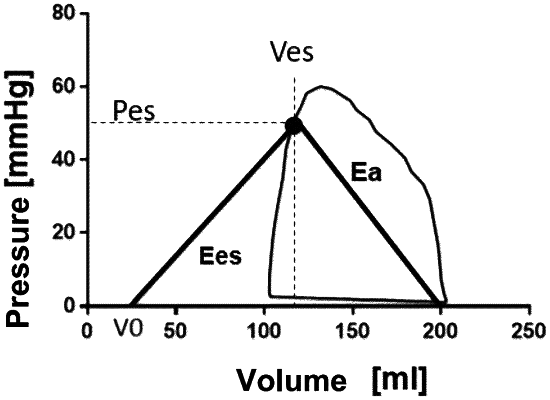| CPC A61B 8/04 (2013.01) [A61B 8/06 (2013.01); A61B 8/5207 (2013.01)] | 4 Claims |

|
1. A method for non-invasively determining contractility independent of load (Ees) for at least one ventricle of a person being examined, comprising the steps of:
Ia) determining the chronological profile of a blood pressure during the isovolumetric contraction (IVK) and the isovolumetric relaxation (IVR) of the at least one ventricle by taking a plurality of blood pressure measurements over at least one period of one heartbeat of the person, wherein a plurality of pressure curves are generated corresponding to each measurement of the blood pressure profile, and wherein the blood pressure is measured by a blood pressure measuring device,
Ib) determining, by a processing element, the velocity (v) of the regurgitation flow through the tricuspid valve from at least one of the plurality of pressure curves from step Ia),
Ic) calculating, by the processing element, the maximum right ventricular pressure (Pmax) from the velocity (v) of the regurgitation flow from step Ib),
Id) obtaining a calibrated pressure curve by calibrating at least one of the plurality of pressure curves from step Ia) using the IVR and IVK times from step Ia) and the maximum right ventricular pressure (Pmax),
Ie) obtaining a calibrated normalized pressure curve by normalizing the at least one calibrated pressure curve from step Id),
II. determining the profile of the blood volume over time during isovolumetric contraction (IVK) and isovolumetric relaxation (IVR) of the at least one ventricle by taking a plurality of blood volume measurements over the at least one period of one heartbeat of the person, wherein a plurality of volume curves are generated corresponding to each measurement of the volume profile,
III. determining the end-systolic volume (Ves) from the at least one of the plurality of volume curves from step II, and determining the end-systolic pressure (Pes) from the at least one of the plurality of pressure curves from step I,
IV. determining the intercept (V0) wherein V0=−50.01 ml+0.7*Ves from the end-systolic volume (Ves) from step III,
V. determining contractility independent of load (Ees) of the ventricle being examined based on the end-systolic pressure (Pes) from step III, the end-systolic volume (Ves) from step III, and the intercept (V0) from step IV, wherein contractility independent of load (Ees) of the ventricle is the slope of the volume curve between the intercept (V0) and the end-systolic pressure (Pes), and Ees=Pes/(Ves-V0).
|